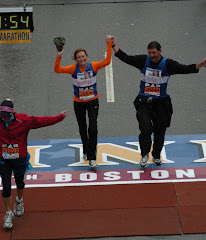She may have a point. I recently decided to fix a burner on our cook top. Online it was described as a 20 min. job and needs a $30 part. Several trips to the parts store, several hours of finagling and $100 later I managed to fix the burner but took out the burner light in the process. Pam would call it a comedy of errors, I call it a learning experience.
But what does this have to do with running? To some degree it’s that same "I can fix it myself" mentality that carries over into running injuries. I just don’t find it rewarding to run off to a doctor every time I get a cold, some achy joint or muscle, or flu symptoms (another guy thing?). I figure I can fix it myself or worst case it will degrade to something worst like pneumonia or torn tendon and then I can justify I need a professional to help. Part of this is learned behavior. I get injured running, I go to the doctor, they ask me how it did it, I tell them, and they tell me to stop running. Like that is going to happen.
But there are times when you do need to turn to a professional. I was on a run with my daughter one day and I rolled my ankle on a curb. I jump back up and start limping around saying "It’s OK, I’ll just walk it off" (another guy thing?). Within a minute I had a muffin top forming over the top of my shoe. OK, so I can’t walk it off, but if I just ice it the swelling will go down and it will be OK. Next day when the foot turned black (not black and blue…black) it seemed appropriate to get it checked. Eight weeks later I got off the crutches and out of the cast.
This year I reached another one of those points. Last year I ran 3 marathons in less than 12 months without any serious injuries. But in the fall I came up lame with a mysterious back of the knee/hamstring problem. Even resting it for a couple of months didn’t seem to make a difference. So I found it completely rational to go seek professional help. I went online. But despite the sage advice of other runners nothing I seemed to do could heal the injury. I finally broke down and went to a doctor.
Apparently I’m not alone. A recent study found that 50% of runners get sidelined each year due to injuries. The aging population of runners and accumulated injuries over the years have a lot to do with that. I’d say I’m guilty on both counts. Some of these injuries come with classy names like, Dead Butt Syndrome, Nippi Erectie Rubatosis, Shin Splints, Blackened Toenails, Runner’s Knee, and Snapping Hip. But most of these injuries are fairly minor and with some early advice/research and a bit of TLC they can be handled by the runner. One thing running does teach you is to listen to your body. Pam would say listening isn’t my strong suit but relative to running I think I’m getting better at it.
We haven’t fixed my problem but between the doctor and I we managed to get me to where I can run, although very slow and with limited mobility. It looks like it will be another one of those years where we won’t know until the second half whether the legs will hold up or not. But of course it they don’t, I can always try to fix it myself.

